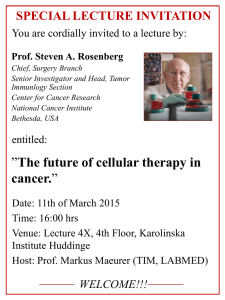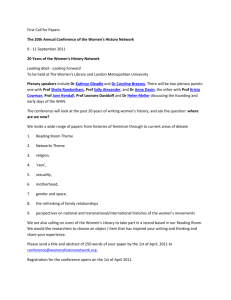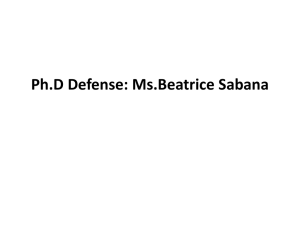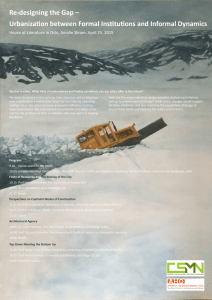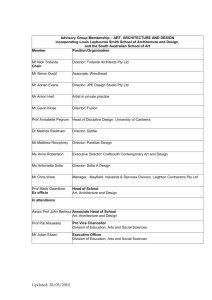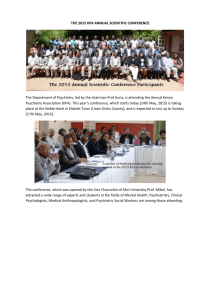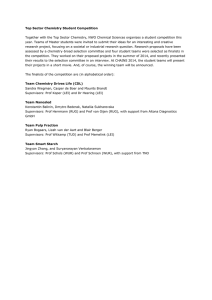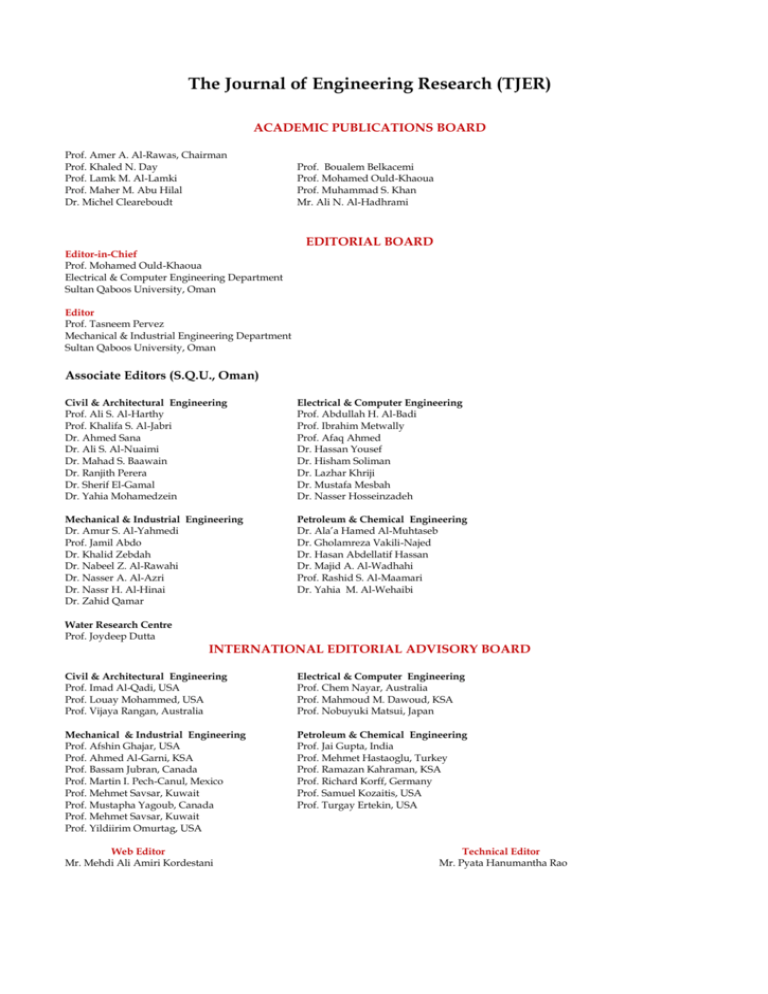
The Journal of Engineering Research (TJER)
ACADEMIC PUBLICATIONS BOARD
Prof. Amer A. Al-Rawas, Chairman
Prof. Khaled N. Day
Prof. Lamk M. Al-Lamki
Prof. Maher M. Abu Hilal
Dr. Michel Cleareboudt
Prof. Boualem Belkacemi
Prof. Mohamed Ould-Khaoua
Prof. Muhammad S. Khan
Mr. Ali N. Al-Hadhrami
EDITORIAL BOARD
Editor-in-Chief
Prof. Mohamed Ould-Khaoua
Electrical & Computer Engineering Department
Sultan Qaboos University, Oman
Editor
Prof. Tasneem Pervez
Mechanical & Industrial Engineering Department
Sultan Qaboos University, Oman
Associate Editors (S.Q.U., Oman)
Civil & Architectural Engineering
Prof. Ali S. Al-Harthy
Prof. Khalifa S. Al-Jabri
Dr. Ahmed Sana
Dr. Ali S. Al-Nuaimi
Dr. Mahad S. Baawain
Dr. Ranjith Perera
Dr. Sherif El-Gamal
Dr. Yahia Mohamedzein
Electrical & Computer Engineering
Prof. Abdullah H. Al-Badi
Prof. Ibrahim Metwally
Prof. Afaq Ahmed
Dr. Hassan Yousef
Dr. Hisham Soliman
Dr. Lazhar Khriji
Dr. Mustafa Mesbah
Dr. Nasser Hosseinzadeh
Mechanical & Industrial Engineering
Dr. Amur S. Al-Yahmedi
Prof. Jamil Abdo
Dr. Khalid Zebdah
Dr. Nabeel Z. Al-Rawahi
Dr. Nasser A. Al-Azri
Dr. Nassr H. Al-Hinai
Dr. Zahid Qamar
Petroleum & Chemical Engineering
Dr. Ala’a Hamed Al-Muhtaseb
Dr. Gholamreza Vakili-Najed
Dr. Hasan Abdellatif Hassan
Dr. Majid A. Al-Wadhahi
Prof. Rashid S. Al-Maamari
Dr. Yahia M. Al-Wehaibi
Water Research Centre
Prof. Joydeep Dutta
INTERNATIONAL EDITORIAL ADVISORY BOARD
Civil & Architectural Engineering
Prof. Imad Al-Qadi, USA
Prof. Louay Mohammed, USA
Prof. Vijaya Rangan, Australia
Electrical & Computer Engineering
Prof. Chem Nayar, Australia
Prof. Mahmoud M. Dawoud, KSA
Prof. Nobuyuki Matsui, Japan
Mechanical & Industrial Engineering
Prof. Afshin Ghajar, USA
Prof. Ahmed Al-Garni, KSA
Prof. Bassam Jubran, Canada
Prof. Martin I. Pech-Canul, Mexico
Prof. Mehmet Savsar, Kuwait
Prof. Mustapha Yagoub, Canada
Prof. Mehmet Savsar, Kuwait
Prof. Yildiirim Omurtag, USA
Petroleum & Chemical Engineering
Prof. Jai Gupta, India
Prof. Mehmet Hastaoglu, Turkey
Prof. Ramazan Kahraman, KSA
Prof. Richard Korff, Germany
Prof. Samuel Kozaitis, USA
Prof. Turgay Ertekin, USA
Web Editor
Mr. Mehdi Ali Amiri Kordestani
Technical Editor
Mr. Pyata Hanumantha Rao
The Journal of Engineering Research (TJER)
AIM AND SCOPE
The Journal of Engineering Research (www.tjer.net) is a refereed international publication of Sultan
Qaboos University. The Journal aims to provide a medium through which engineering researchers and
scholars from around the world are able to publish their scholarly applied and/or fundamental research.
Contributions of high technical merit are to span the breadth of engineering disciplines.
They may cover, the main areas of engineering: Electrical, Electronics and Computer Engineering,
Information Engineering and Technology, Mechanical, Industrial and Manufacturing Engineering,
Aerospace Engineering, Automation and Mechatronics Engineering, Materials, Chemical and Process
Engineering, Civil and Architecture Engineering, Biotechnology and Bio-Engineering, Environmental
Engineering, Biological Engineering, Genetic Engineering, Petroleum and Natural Gas Engineering,
Mining Engineering and Marine and Agriculture Engineering.
ACCEPTANCE AND REVIEWING PROCESS
All papers submitted to the Journal will be subjected to rigorous reviewing by a minimum of two
reputable referees who are technically competent to evaluate the subject matter. Upon the acceptance of
the contribution for publication it is possible that papers may be subject to minor editorial amendments.
However, authors are solely responsible for the originality and accuracy of the findings in their papers.
Statements, results and findings published in the Journal are understood to be those of the authors, not
those of the Editorial Board or the publisher.
SUBMISSION OF MANUSCRIPTS
Submission of manuscripts in soft (electronic) format is preferred. Author(s) are requested to send an email with an electronic version of the manuscript.
Submissions should be sent directly to:
Editor-in-Chief,
The Journal of Engineering Research,
College of Engineering,
Sultan Qaboos University,
P. O. Box 33, P.C. 123 Al-Khoud
Muscat, Sultanate of Oman.
E-mail: Chief-Editor@tjer.net or raoh@squ.edu.om
TJER is currently Indexed in Scopus
The Journal of Engineering Research (TJER). All rights reserved. This journal is not responsible for
opinions printed in its publication. They represent the views of the individuals to whom they are
credited and are not binding upon the journal.
Sultan Qaboos University Press, Muscat, Sultanate of Oman, 2015.
CONTENTS
Arginine-Amino Acid Interactions and Implications to Protein Solubility
and Aggregation
01
Dynamics of a Carriage System of Comparator for Calibrating the
Line Standards of Length
15
A.R Shaikh and D. Shah
A. Kilikevicius, V. Vekteris and V. Moksin
Efficient Desalination of Brackish Ground Water via a Novel Capacitive
Deionization Cell Using Nanoporous Activated Carbon Cloth Electrodes
22
Variation in Methane Concentration Produced from Anaerobically Digestive
Vegetables
32
K. Laxman, M.T.Z. Myint, M. Al-Abri, L. Al-Gharibi, B. Al-Namani, H. Bourdoucen and J. Dutta
H. Mousa and M. Silwadi
Kinetics and Mechanism of Bulk Polymerization of Vinyl Chloride in a
Polymerization Reactor
41
A.S. Ibrahim, Y.A. Ali, H.M. Saad and I.H. Amur
Loss Reduction in Isolated Rural Area Distribution Network Using Photovoltaic
System
51
M.H. Al-Badi, N.A. Al-Mashaikhi, S. Al-Hinai, R.S. Al-Abri, A.S. Al-Hinai, Q.K. Al-Aamri, A.A. Al-Mazidi
and Ms. Al-Gafri
Drag Reduction Properties of Nanofluids in Microchannels
60
H.A. Abdulbari and F.L.W. Ming
Overdesign of Villa Structures in Oman
A.S. Alnuaimi, M. Mohsin, A. Hago and S. El Gamal
68
Notes for Authors
MANUSCRIPT PREPARATION
Length of Manuscript
Papers submitted for publication in TJER could be up to ten
printed pages or 24 to 30 double spaced pages. The
template for MS-WORD as per TJER format may be
downloaded from http://www.tjer.net. It is advisable that
authors use this template in order to reduce the amount of
time spent on typesetting the manuscript. The font sizes
and the manuscript specifications are outlined as follows.
Typing and Font Specification
Manuscripts should be typed double-spaced on one side of
a sheet only, with margins of about 2.5 cm on each side of
each page. The font should be Times New Roman for all
the components of the manuscript with font size of 12 pt
and regular attribute for the body of the text.
Elements of the Manuscript
Full length papers generally consist of the title, author(s)
affiliation(s), abstract, keywords, nomenclature if
applicable, introduction, body, conclusion, references, list
of figures and table captions, and original figures and
tables for reproduction.
A paper may also include
appendices and acknowledgments.
Titles
Capitalize the first letter of each word, i.e. use title case.
Author Names and Affiliation(s)
Author names on technical papers should include the name
of each author followed by his/her company affiliation. If
two or more authors have the same company affiliation, it
should not be repeated after each name. Do not use titles
such as Mr., Mrs., Ms., Miss, Prof. or Dr.
Abstract
The abstract should be limited to 300 words and must
concisely state what was done, how it was done, principal
results, and their significance. The abstract will appear
later in various indices of abstracts and should contain the
most critical information within the paper.
Keywords
Leave two blank lines after the abstract and type 6-10 key
words and phrases (separated by semicolons) that can be
used to index the paper, listing the keywords in order of
importance for indexing. Do not repeat words or strings of
words from the title. Capitalize the first letter of each word.
Acknowledgments
The same format as the body of the text should be
followed.
Nomenclature
A separate nomenclature section should list in detail the
symbols used in the manuscript, their definitions, and their
units in SI system. The nomenclature list should be an
alphabetical order with Greek symbols following the
alphabetical listing.
Subscripts and superscripts should follow Greek symbols
and should be identified with a heading.
References
The references should be included at the end of the
manuscript in a separate section named References without
a number.
All references must be listed alphabetically by first name of
the first author. Ensure that the reference information is
complete and accurate, including as necessary and in the
following order: first names and initials of all authors; year
of publication; title of paper, report, or book chapter (in
quotes); title of book or periodical (in italics); volume and
issue numbers; name and location of publisher (for books),
name and location of publisher or sponsor (for
proceedings), or city of publication and inclusive page
numbers.
Figures
All figures must be cited in the body of the paper. Figures
should be numbered in Arabic numerals in the order in
which they are cited. Related figures or figure sections
may be labeled with a shared numeral and consecutive
lowercase letters (eg. Figs. 1a through 1d).
Figures should be the smallest size possible without loss of
clarity, preferably designed to occupy a single column (8.2
cm of width) of a printed journal page. Once the paper is
accepted for publication, separate file for each figure in .tif
or .tiff format is to be submitted to the technical editor for
final printing.
Tables
All tables must be cited in the body of the paper. Tables
should be numbered in Arabic numerals in the order they
are cited in the paper. Tables should be the smallest size
possible without loss of clarity.
Table headings and column headings should be as concise
as possible. Column alignment should be obtained using
tabs NOT spaces. Tables should be designed to occupy a
single column or the full width of the page.
Care should be taken to avoid any arrangement that
unduly increases the depth of a table. Use 10-point Times
New Roman bold, centered, for table headings and 10point Times New Roman for body in tables.
Mathematical Notations and Equations
To avoid errors in editing and typesetting, authors should
clearly identify subscripts, superscripts, Greek letters, and
other symbols.
Equations should be numbered using Arabic numerals
placed in parentheses. Break equations to fit within the
page. Avoid ambiguities in equations and fractions in text
through careful use of parentheses, brackets, solids (slants),
etc.
Note that in-text, fractions are usually “broken down” to fit
in one line and confusion can result if terms are not
properly labeled. The conventional order of brackets is
{[0]}.
Units and Abbreviations
The International System of Units (SI units) is required.
Unit symbols should be used with measured quantities, ie.
1 mm, but not when unit names are used in text without
quantities, ie. “a few millimeters.”
Acronyms and
abbreviations should be defined the first time they are used
in the text.

